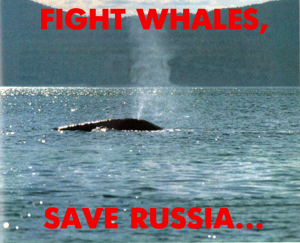 |
REGIONAL INFORMATION DIGESTECONOMY, ECOLOGY, HISTORY, CULTURE |
# 2, 1997

BY Sergei PONOMARYEV
Eventually, spotted was the bitterest enemy of
the domestic fisheries, named whale, or nicknamed gorbach
(humpback), serii (gray), morskaya svinya (sea-hog), polosatik
(striped-back), belukha (white-belly), butilkonos (bottle-nose).
It keeps breeding, you know! The ichthyologists of all state
departments concerned are ringing the alarm bell: "Evident
whale overpopulation is observed in the White, Barents, Bering
and Black seas, which leads to a decrease of fish resources
within those basins".
However, it seems we are not the first victims. Two weeks ago,
Iceland, though small but one of the largest seafood producing
countries, declared: "We have had enough! In spite of all
taboos imposed by International Whaling Commission (IWC) we are
going to land 200, and not less, whales this year "to meet
the needs of the industry". Earlier yet, Norway
single-handedly allocated a quota of 400 whales doomed to be
slaughtered within the next few months.
The Japanese are wide awake either. Last week they met with
Russian representative at the IWC, Chairman of Russian Federation
State Committee on Ecology ("Goskomecologia"), Vladimir
Iliashenko. The purpose of the negotiations is to get support
from Russia in the effort to tone down the control over the
harvesting of various whale species.
So, generally speaking, whales beware! It's time to put you in
check with the use of harpoons, special saws and cutting axes.
Not in such a barbaric fashion as before, but rational, delicate,
scientifically approved.
However, a scholar of some authority, Alexey Yablokov, heading
Interdepartmental Commission on Ecology of Russian Security
Council, is reported to state that there had been no facts
confirming the alleged increase in the Belukha whale population
in the northern seas. Besides, the Belukha whale does not feed on
cod and therefore cannot upset its abundance. If some of whale
species really did increase in number, that should be Polosatik
whale inhibiting the Antarctic. But there locates the
international reserve where even scientific research whaling is
prohibited.
Today, 15 years since the declaration of the International
Moratorium on any commercial catching of sea mammals (the ex-
Soviet Union joined the Moratorium in 1987), populations of the
largest and valuable Greenland Whales is short of 2,000, while
gray whales, according to domestic and international estimations,
are slightly over 12,000.
What drives the statesmen and interdepartmental science who ever
more intensively push the idea of resumed whaling? Everyone knows
that this country has neither technical means nor qualified
personnel to accomplish this.